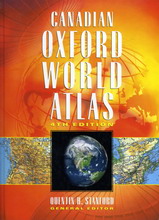
| Home News Releases | Calendar Contact |
Sources Bookshelf

Canadian Oxford World Atlas 4th Edition
Stanford, Quentin H. (ed.)
Publisher: Oxford University Press, Oxford, United KingdomYear Published: 1997
Pages: 219pp Price: $29.95 ISBN: 0-19-541319-9
Please see our media profile in Sources:
Sources Select Resources
When I was a young child I would borrow my aunt's old dog-eared atlas and seek out new places to visit in my mind. Although it was filled with gray and pastels, an abundance of travel fantasies and childhood games came out of the places my cousins and I invented sifting through that book. The Canadian Oxford World Atlas also contains fodder for creative minds and a wealth of information. To start you off on the right leg on your world journey there is a World Time Zone Map on both the inside front and back covers. The Table of Contents is very helpful with abundant detail.
There is also an extremely useful section about "Understanding Topographic Maps" on page 4. This provides information on the common symbols found on the different maps in the Atlas. There are also explanatory ages on Latitude, Longitude, and Scale; Direction and Satellite Imagery.
When providing information on Canada, this Atlas lives up to its title. There are Canada-specific maps pertaining on, for example, Endangered Species and Protected Lands, Water Resources and Electrical Power; Native Peoples, Eastern Exploration, Arctic and Western Exploration, Territorial Evolution and many others.
Most of these maps contain relevant information. The Territorial Evolution Map contains no projection of the recent addition of the Territory of Nunavut. I am not sure what kind of information can be gleamed from the rather ambiguous Political Division Map.
The maps of various provinces are accompanied by small corner legends for land height, boundaries, city and town symbols. There are also handy statistics on census population and gross domestic product in the top right corner.
Unfortunately equal attention is not paid to all provinces. The Atlantic Provinces and Northern Canada are dumped on a two-page spread each. Of course Vancouver, Toronto, Ottawa, Halifax and Montreal get their own half page map.
For maps of the United States, Oxford decided to include maps of the North East United States, California and a two-page general United States map. Why did Oxford pick these locations? It is not clear why these particular areas warranted extra attention.
The other continents are just shown in maps by continent focusing on climate, land use, population and communications. Few countries apart from Canada and the United States get a map to themselves and that is a bit of an annoyance.
There are also global maps focusing on a wide variety of subjects, including maps on timely issues such as Environmental Damage, Global Warming, Atmospheric Pollutants, Fresh Water and Protected Areas, Nuclear and Armaments, Population, and Changing Quality of Life.
There is a 39-page index which gives you the alternate spelling, country, page number, grid code, latitude & longitude of the location you are seeking.
After the Index, the final 33 pages are statistics from Statistics Canada on just about everything you want to know about Canada's geography and population. The statistics are displayed in colorful grids that make them easy to read. There are also a few statistics on world population, expenditures and growth.
What I really like about this atlas is its versatility. The junior high student writing an essay can use it as well as the university major who will be able to make great use of its statistics and focus on current global issues.
[Review by Nicole Redman]
Subject Headings
© Sources 2023. The information provided is copyright and may not be reproduced in any form or by any means (whether electronic, mechanical or photographic), or stored in an electronic retrieval system, without written permission of the publisher.